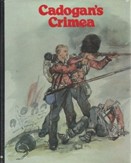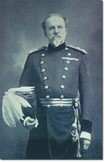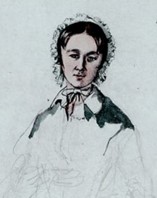
Hamish Hamilton London, 1979
Reviewed by Norman E. Gough, South Staffordshire, UK
The current war in Ukraine, following the annexation of the Crimean peninsula by Russia, is an unwelcome reminder that such places of strategic military interest have always been in the firing line. Lt. Gen. Sir Somerset John Gough Calthorpe (1831-1912) was with Gen. Sir George Cadogan (1840-80) in the British campaign of 1854 that led to the fall of Sevastopol the following year.

He was the son of Charlotte Sophia Somerset and Frederick Gough-Calthorpe, a descendant of the Goughs of Staffordshire and was indirectly related to Cadogan.1 This abridged version of Somerset’s full diaries of the war is illustrated by fine watercolours painted by George Cadogan, and is now available on-line.2 3
This is a vivid account of the major incidents, including battles at Alma, Balaklava, Inkerman, Eupatoria and Sevastopol, and is particularly informative as to how French, British and Turkish allies worked together. Several oddities stand out for me: Disciple seems to have been a problem, as shortly after landing, the cheap booze was irresistible to the soldiers and a large percentage of the unit was found to be drunk. He also describes one skirmish as “the prettiest thing I ever saw”; and goes on to explain how the wives of officers accompanied their husbands on this ‘expedition’, one of whom even gave birth in a tent.

A war that resulted in at least 250,000 casualties, more than half resulting from cholera, hardly seems like a good destination for a sight-seeing trip! On the other hand, the destruction of war in those days seems slight, when compared to that resulting from later encounters: The loss of the cavalry in the disastrous Charge of the Light Brigade made relatively little impact on the environment. However heavy guns were carried by railway and Sevastopol was bombarded six times by 307 cannon resulting in heavy casualties on both sides. Sevastopol was also destroyed by the Nazis in 1942, after which few buildings remained standing and it took more than ten years to rebuild the city.

The author does mention briefly the work of Florence Nightingale and includes a small drawing of her but otherwise there is little mention of the sterling work carried out by the nurses under very trying conditions, and his comment about those found in a Balaklava hospital is far from being politically correct: “.. they are none of them young, all rather fat and motherly looking women, and quite come up to one’s ideas of orthodox nurses”.
Whilst the full diaries are probably only of interest to military historians, this short version is well-presented and should appeal to anyone with a general interest in the history of the Crimea. What makes it especially appealing is that it is an eye-witness account and Cadogan’s pictures give a rare glimpse into what it actually looked like.
1 N.E. Gough, Goff/Gough Origins in the British Isles 3. Staffs, Goffs/Goughs: Their ancestors and Descendants, Winter 2021
2 https://archive.org/details/cadoganscrimea0000cado_t1c9/page/n1/mode/2up
3 https://www.geni.com/people/Lt-Gen-Sir-Somerset-John-Gough-Calthorpe/6000000020422571238
Editor’s Note: We invite others to submit reviews of books written by or about others in our Goff-Gough family. Please send to info@goff-gough.com.
